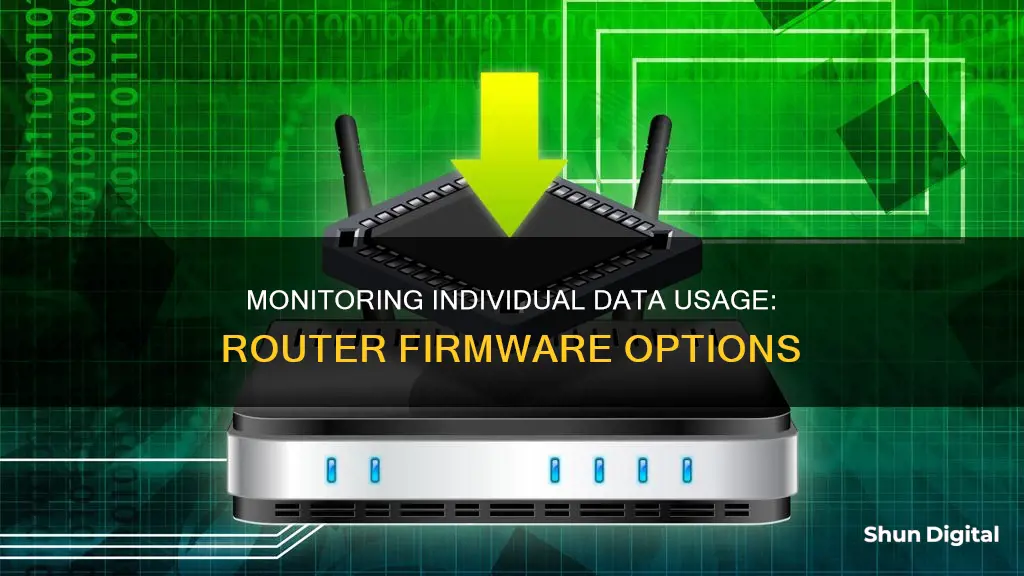
Monitoring data usage on a home network can be challenging, especially when multiple devices with different operating systems are involved. While routers are the single point through which all data transfers occur, most home routers lack built-in data management capabilities or user-friendly tools for tracking data usage. This is where third-party router firmware comes into play. Solutions like DD-WRT, Gargoyle, Tomato, and OpenWRT offer features such as live bandwidth usage monitoring, per-device data usage history, and the ability to enforce quotas on specific devices. However, utilising these third-party options may require above-average technical knowledge and experience. For those seeking an off-the-shelf solution, some routers, such as those from ASUS and Ubiquity, offer data tracking capabilities, albeit with potential limitations and the need for additional storage for extended logging.
| Characteristics | Values |
|---|---|
| Monitor bandwidth and data usage of individual devices | DD-WRT, Gargoyle, My Page add-on, wrtbwmon script, luci-wrtbwmon, GlassWire, Bandwidth+, Wireshark, NetWorx, NetGenius |
| Monitor bandwidth and data usage of routers | TP-Link, Linksys, NETGEAR, ASUS, Buffalo, Asus |
What You'll Learn

Third-party router firmware
While most home routers do not have built-in data management capabilities, there are third-party router firmware options that can give your router this functionality.
DD-WRT
DD-WRT is one of the most popular third-party router firmware options. It offers the ability to see live bandwidth usage and check which devices are using the most data at any given moment. It also has the ability to keep track of how much data has been uploaded and downloaded each month. DD-WRT is free and available for a wide range of routers, including some that come with the firmware pre-installed, such as Buffalo routers, and others that are compatible with the firmware, such as Asus routers.
Tomato
Tomato is another popular third-party router firmware option. It is based on the OpenWrt kernel and offers advanced QoS, as well as Ajax and SVG graphs. Tomato is available for purchase pre-installed on certain routers, such as the Linksys WRT AC3200.
Gargoyle
Gargoyle is a free, OpenWrt-based Linux distribution for a range of Broadcom and Atheros chipset-based wireless routers. It is designed specifically for bandwidth and data usage monitoring and can enforce quotas on specific devices to prevent them from using too much data. Gargoyle mostly supports TP-Link devices, as well as some Buffalo, Netgear, and Linksys routers.
OpenWrt
OpenWrt is a customizable, open-source firmware written from scratch. It features a combined SquashFS/JFFS2 file system and a package manager with over 3000 available packages. OpenWrt does not have a built-in graphical user interface, but this can be added using X-Wrt, which also includes the ability to monitor and manage your router remotely via a web interface.
Hotels and Internet Privacy: Monitoring Guest Online Activity
You may want to see also

Router monitoring limitations
While monitoring data usage on a router can provide valuable insights into network performance and security, there are certain limitations to this approach. Here are some key limitations to consider:
- Inadequate router capabilities: Most home routers lack built-in data management capabilities, making it challenging to monitor bandwidth usage effectively. While some higher-end routers offer data tracking, they may not provide per-device bandwidth status or a detailed history of data usage.
- Complexity: Monitoring router traffic can be complex, especially for those without technical expertise. It often requires custom router firmware, third-party applications, or network monitoring tools to capture comprehensive data.
- Limited historical data: While routers can provide real-time bandwidth usage information, tracking data usage over an extended period can be more challenging. This requires additional storage on the router or the use of third-party solutions.
- Inability to track individual devices: Routers typically provide aggregate data usage information, making it difficult to pinpoint the usage of specific devices. Identifying individual devices requires unique IP or MAC addresses, which may not always be available or easily accessible.
- Inconsistent results: The effectiveness of router monitoring can vary depending on the brand and model of the router. Different routers have distinct interfaces and capabilities, and some may not provide detailed performance data or bandwidth monitoring sections.
- Security and performance risks: Restricting and controlling internet traffic on a router can introduce security risks and reduce overall performance. Malicious actors may exploit vulnerabilities, and the increased complexity can make the router more challenging to manage and troubleshoot.
- Cost implications: Implementing effective router monitoring may require additional hardware or software investments. This can increase costs, especially for organizations or individuals managing multiple routers or a large number of connected devices.
- Inability to capture all traffic: Router monitoring may not capture all network traffic, especially in hybrid networks with wireless routers. Wireless networks have different operating methods and transmission protocols, which can result in incomplete records of network performance.
Monitoring JVM Memory Usage on Linux: A Practical Guide
You may want to see also

Individual device monitoring
Monitoring data usage on individual devices connected to your router can be challenging, as it often involves a mix of devices with different operating systems. While some routers offer basic data-monitoring features, they typically lack per-device data usage history.
To effectively monitor data usage on individual devices, you can employ third-party router firmware, such as DD-WRT, Gargoyle, or Tomato. These firmwares provide more advanced data-monitoring capabilities, allowing you to track live bandwidth usage and identify devices consuming the most data. However, this approach may require technical knowledge and expertise.
Another option is to use monitoring applications like NetWorx or NetGenius, which offer user-friendly interfaces, extensive logs, and usage history. However, these applications are limited to specific operating systems, and you would need to install them on each device you want to monitor.
Additionally, some routers offer individual device tracking by providing the MAC address of connected devices. You can also use third-party network analyzer tools, such as Wireshark, for more detailed insights into your network traffic and data usage on individual devices.
It's worth noting that some Internet Service Providers (ISPs) may provide graphs or reports of your data usage, which can be useful in understanding overall consumption, but they typically do not offer device-wise reports.
In summary, while monitoring individual device data usage can be challenging, utilizing third-party router firmware or device-specific monitoring applications can provide more detailed insights into data consumption on your network.
Monitoring Android Memory Usage: Tips and Tricks
You may want to see also

Monitoring applications
There are two main ways to monitor network traffic: directly through the router or using third-party network monitoring software. Most home routers have some form of built-in data tracking that can be accessed via the router's admin settings page. However, many routers do not have built-in data management capabilities, so you may need to use third-party router firmware or a network monitoring tool to get more detailed information.
Third-Party Router Firmware
If you want more detailed data usage information than what your router provides, you can use third-party router firmware. DD-WRT is a popular option that offers the ability to see live bandwidth usage and check which devices are using the most data. The My Page add-on for DD-WRT allows you to monitor data usage over an extended period, but it requires additional storage on your router, such as a device plugged into USB storage. Buffalo offers routers with DD-WRT pre-installed, and Asus routers are also compatible with DD-WRT.
Another option is Gargoyle, an OpenWRT-based router firmware designed specifically for bandwidth and data usage monitoring. It can also enforce quotas on specific devices to prevent them from using too much data.
Third-Party Network Monitoring Tools
If you're looking for even more advanced features and detailed analytics, you may want to consider a third-party network monitoring tool. Here are some popular options:
- Wireshark: A free and widely used network-monitoring tool that can be used to monitor your network traffic in detail. It can capture live network traffic and provides various sections to inspect captured packets, including packet lists, packet details, and packet bytes.
- ManageEngine NetFlow Analyzer: A real-time network monitoring tool that uses flow data and can detect environmental changes and set alerts. It offers a 30-day free trial.
- Paessler PRTG Network Monitor: This tool auto-detects and monitors all connected network routers, providing useful performance data for identifying faults and traffic bottlenecks. It also includes a free version for up to 100 sensors.
- SolarWinds NetFlow Traffic Analyzer: Infrastructure monitoring software that offers bandwidth and network performance monitoring through a performance analysis dashboard. It can identify bandwidth-hogging applications or devices and offers a 30-day free trial.
- ManageEngine OpManager: A powerful and user-friendly network monitoring tool that monitors a wide range of devices, including routers, switches, firewalls, servers, and virtual machines. It offers a comprehensive suite of monitoring capabilities and provides detailed insights into network and device performance. It also offers a 30-day free trial.
- Paessler PRTG Router Monitoring: This tool helps you stay on top of the health and performance of your routers, monitoring bandwidth consumption, network traffic, and the physical health of routers. It supports routers from major manufacturers like Cisco, Linksys, and Netgear. It offers a free trial, but pricing can be expensive for larger-scale usage.
- Site24x7 Network Monitoring: A cloud-based network monitoring tool that offers an impressive range of capabilities, including router monitoring, network discovery, inventory creation, and topology mapping. It also provides historical traffic analysis and supports multiple networks under one account, making it ideal for businesses of all sizes and Managed Service Providers (MSPs). It offers a 30-day free trial.
- WhatsUp Gold: A free and easy-to-install network monitoring tool that provides full visibility into the performance of routers and servers. It also supports compliance standards like HIPAA, SOX, and PCI DSS, making it ideal for businesses in regulated sectors.
- Nagios: A free and open-source application for monitoring systems, networks, devices, and infrastructure. It offers powerful script APIs to monitor custom applications and provides a centralized view of the entire IT infrastructure. It may be more complicated for beginners due to its open-source nature.
- Zenoss: A unified monitoring software for complex network environments and a multitude of devices. It provides dynamic dashboards, proactive anomaly detection, and real-time data analysis. It is free to download but may be challenging to troubleshoot and fix problems.
- OpenNMS: Another open-source monitoring platform with two versions: Horizon for quick innovations and Meridian for long-term stability. It provides out-of-the-box support for many applications and devices, remote monitoring options, and flexible architecture. It is recommended for businesses chasing innovations or valuing long-term stability.
- Zabbix: A popular network monitoring tool suitable for all sizes and types of IT infrastructure. It collects metrics from various sources, provides root cause analysis, trend predictions, and intelligent alerting. It has an intuitive GUI, making it accessible even for those without a deep technical background. It is open-source and free to use.
Setting Up a Power Usage Monitor: A Step-by-Step Guide
You may want to see also

Firmware updates
Understanding Firmware Updates
Checking for Updates
The process of checking for firmware updates can vary depending on your router manufacturer and model. Here are some general steps to follow:
- Log in to your router's administration page by entering its IP address in a web browser. The default IP address is usually found in the router's manual or printed on a label.
- Navigate to the "Administration" or "Management" section of the router's settings.
- Look for an option labeled "Firmware Update," "Router Update," or something similar. This is where you can check for available updates and initiate the update process.
Downloading and Installing Updates
When an update is available, follow the instructions provided by the router manufacturer. Typically, you'll need to download the firmware file from the official website and then upload it to your router through the administration page. Here are some important considerations:
- Always download firmware updates from the official manufacturer's website to ensure you're installing the correct and secure version.
- Before proceeding with the update, make sure your router is connected to a stable power source to avoid interruptions during the process.
- It's recommended to back up your current router configuration so you can restore it if needed.
- During the update process, do not turn off the router or interrupt the power supply.
Benefits of Firmware Updates
- Enhanced Security: These updates often patch security vulnerabilities and protect your network from potential threats and malicious attacks.
- Improved Performance: Updates can bring speed boosts, better signal stability, and enhanced data transfer rates, resulting in a smoother online experience.
- New Features: Manufacturers may introduce new functionalities, such as improved parental controls, guest networks, or advanced QoS (Quality of Service) settings.
- Bug Fixes: Firmware updates address known issues and fix bugs that may have been causing problems with your network or specific devices.
Potential Risks and Troubleshooting
While firmware updates are generally safe, there are a few potential risks to be aware of:
- Incompatible Updates: Sometimes, a firmware update may not be fully compatible with your specific router model, leading to unexpected issues. Always check the manufacturer's release notes and your router's model number before proceeding.
- Power Interruptions: If the power is interrupted during the update process, it could leave your router in a non-functional state. Ensure a stable power supply before initiating an update.
- Bricking: In rare cases, a firmware update may "brick" your router, rendering it unusable. This can happen due to power interruptions or installing incorrect firmware.
If you encounter issues after a firmware update, you can try resetting the router to its factory settings and then reconfiguring it. If problems persist, you may need to contact the manufacturer's support team for further assistance.
Monitoring Android CPU Usage: A Comprehensive Guide
You may want to see also







